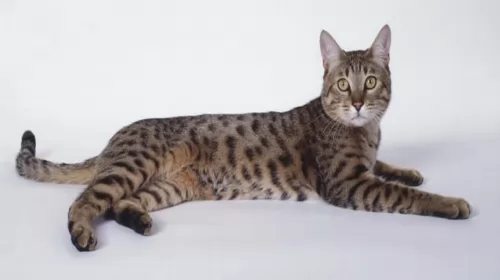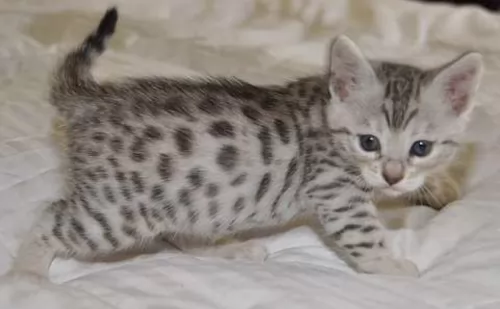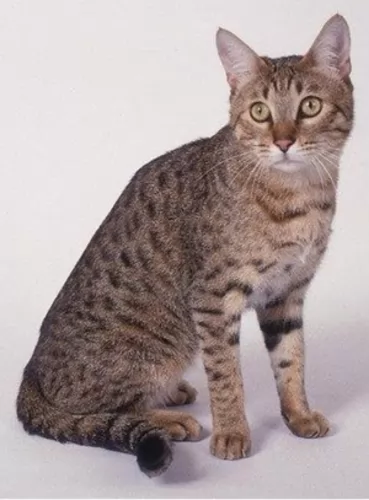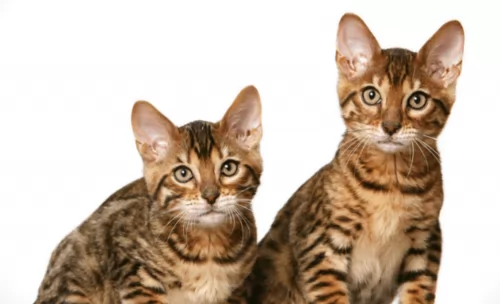 Petzlover
Petzlover Both Bicolor and California Spangled Cat are originated from United States. Both Bicolor and California Spangled Cat are having almost same weight. Bicolor may live 3 years more than California Spangled Cat. Both Bicolor and California Spangled Cat has same litter size. Both Bicolor and California Spangled Cat requires Moderate Maintenance.
Both Bicolor and California Spangled Cat are originated from United States. Both Bicolor and California Spangled Cat are having almost same weight. Bicolor may live 3 years more than California Spangled Cat. Both Bicolor and California Spangled Cat has same litter size. Both Bicolor and California Spangled Cat requires Moderate Maintenance.
 The first thing to know is that a Bicolor cat isn’t in fact a breed. Bicolor is just a term that describes a certain look that a cat has with its coat. It’s a cat with two colors such as red and white or black and white.
The first thing to know is that a Bicolor cat isn’t in fact a breed. Bicolor is just a term that describes a certain look that a cat has with its coat. It’s a cat with two colors such as red and white or black and white.
A popular name for bi-color cats is also Piebald or Tuxedo, and in fact many cat breeds can produce bicolor kittens, or black and white kittens such as Cornish Rex, Maine Coon, Manx, and others.
There are different coat color combinations when it comes to bicolor cats and the black and white markings may be more common but there are other color combinations too such as orange and white.
Nobody seems to know the origins of the Bicolor cats so we are going to assume they come from the USA.
 People seem to want a cat that resembles some of the wild cats we have, and the California Spangled is a domestic cat that has been bred to resemble spotted wild cats.
People seem to want a cat that resembles some of the wild cats we have, and the California Spangled is a domestic cat that has been bred to resemble spotted wild cats.
In fact, it was during the 1970s, that Paul Casey, an American scientist, returned from Tanzania to create a cat breed that resembled a wild cat such as a leopard.
There are many breeds that make up the California Spangled cat and these are the Abyssinian, British Shorthair, Siamese as well as some stray cats. Today, the breed has all but disappeared and there are only a few of the cats left.
 Regardless of the breed they belong to, information on these cats suggests that they can have many different looks. Look at the amazing Turkish Van cat for instance – each of these cats is recognizable for its long, luxurious fur. You’ll find a few touches of color on the cat's ears and tail, making in a Bicolor. They also have an interesting characteristic – being fond of water!
Regardless of the breed they belong to, information on these cats suggests that they can have many different looks. Look at the amazing Turkish Van cat for instance – each of these cats is recognizable for its long, luxurious fur. You’ll find a few touches of color on the cat's ears and tail, making in a Bicolor. They also have an interesting characteristic – being fond of water!
These Bicolor cats weigh in the region of 3 – 7kg, and can tend towards the smaller or larger size. Some of them can have short or long hair, larger or smaller ears and green or yellow eyes.
Coming from different cat breeds, the bicolor cat can have a mix of wonderful characteristics – they can be vocal or quiet or confident or shy.
They’re always wonderful though and can be curious, intelligent, playful, loving and loyal. They make great companions who just love the interaction they have with their human owners.
 The California Spangled cat is lean with a long muscular body and long legs. Its long body makes it look like it is on the prowl like a leopard.
The California Spangled cat is lean with a long muscular body and long legs. Its long body makes it look like it is on the prowl like a leopard.
Its coat, similar to that of a leopard, can be a mix of colors such as black, tan, silver, red and white with a mix of different shaped spots. The coat is fairly short and doesn’t require too much grooming. However, a brush will be like a bonding session for you and your cat and it will keep his coat shiny and free of loose hairs and dust.
The cat has almond-shaped eyes that are amber to copper-colored.
This cat is independent but it still wants to get a lot of attention from his owners. They’re affectionate, social and devoted to their human family. They are known for their intelligence and high energy levels, enjoying games that involve lots of action and participation.
Being an active cat, it needs a lot of space to roam and to play. Because he is smart, buy him interesting toys, a scratching post, and climbing equipment.
 The Bicolor cat is such a steady, reliable cat-friend to have. When you start looking as these cats as your companion, you're going to get a smart, funny, adoring, playful family member who will be there for you whether you go to work each day or stay at home.
The Bicolor cat is such a steady, reliable cat-friend to have. When you start looking as these cats as your companion, you're going to get a smart, funny, adoring, playful family member who will be there for you whether you go to work each day or stay at home.
They’re such easygoing cats, with no airs and graces. They’re happy, relaxed, and uncomplicated cats and when you make a Bicolor your pet and friend, your life just becomes that much more meaningful.
 These active but calm cats are very sociable, liking to talk to only when needed and then the meow of the cat is soft.
These active but calm cats are very sociable, liking to talk to only when needed and then the meow of the cat is soft.
While this cat would prefer being the only cat in the family, they are quite adaptable in the right environment and will adapt to a home where there are other pets.
These are cats that enjoy being the only cat in the house, but they are prepared to adapt to a life shared wth other cats or dogs.
They love playing and will respond well to children who have been taught how to be kind to animals.
They’re pricey cats these but they can certainly provide you with 15 years of great companionship.
 By providing your kitty cat with a loving home, you can ensure that he stays as healthy as possible. Unfortunately though, cats can get sick, regardless of how well you take care of them and then as a responsible pet owner, you will be able to take your pet to your local vet.
By providing your kitty cat with a loving home, you can ensure that he stays as healthy as possible. Unfortunately though, cats can get sick, regardless of how well you take care of them and then as a responsible pet owner, you will be able to take your pet to your local vet.
Some of the common cat problems you get can be kidney disease, ear infections, dental disease, parasites such as heartworm, cancer or something like feline immunodeficiency virus.
Whether your cat has a virus or an infection, remember that getting your cat to the vet can mean nipping the problem in the bud before it gets more serious.
 Caring for your Bicolor cat is much the same as with any other cat. Your Bicolor will shed, so brushing him will tickle him pink, especially if you do it lovingly and gently – it’s like a bonding session. The weekly brushing will get rid of loose hairs and dust and keep the coat healthy and shiny.
Caring for your Bicolor cat is much the same as with any other cat. Your Bicolor will shed, so brushing him will tickle him pink, especially if you do it lovingly and gently – it’s like a bonding session. The weekly brushing will get rid of loose hairs and dust and keep the coat healthy and shiny.
Spay or neuter your pet to avoid unwanted kittens. Stay up to date on veterinary visits and vaccinations.
Provide your cat with stimulating toys as well as all the equipment he needs to be comfortable – food and water bowls, litter box, grooming equipment, bedding, climbing- and scratching equipment.
All cat owners, whether their cats eat homemade food or wet- or dry food should read cat food labels and understand the nutrients content.
Certainly, as a carnivore, cats require certain vitamins, minerals, and proteins that only meat can provide.
Understand how to work out if the cat food is balanced or not and not packed with too many grains and carbohydrates.
How much your Bicolor eats will depend on his age and his activity levels. Be careful not to overfeed your cat as overfeeding is dangerous. When cats put on too much weight, it leads to problems such as diabetes, heart- and joint disease.
 When it comes to feeding these cats, you’ll find that the California Spangled Cat is highly energetic and therefore his food needs to be of the very best high protein that there is.
When it comes to feeding these cats, you’ll find that the California Spangled Cat is highly energetic and therefore his food needs to be of the very best high protein that there is.
The cat requires high-quality food and food that is adapted to his growth and energy levels. If your California Spangled Cat had to hunt for his own food it would be mice and birds - protein.
In your home, he’ll need cat food high in protein. A diet deficient in protein can lead to all kinds of health issues. The reason for this is the protein has amino acids and this plays many essential roles in the body, strengthening the immune system.
Fortunately, in our busy world, commercially manufactured cat foods from top brands are nutritionally complete and balanced, and they’re high-protein cat foods. Proteins are imperative for the functioning of all body parts, and nursing queens for instance may well need more protein to get the kittens off to a good start.
Your California Spangled cat isn’t a huge shedder so a regular brushing once a week of the short coat will get rid of dust and loose hairs.
They’re playful cats these so provide them with games and toys that can help with using up some of this energy.